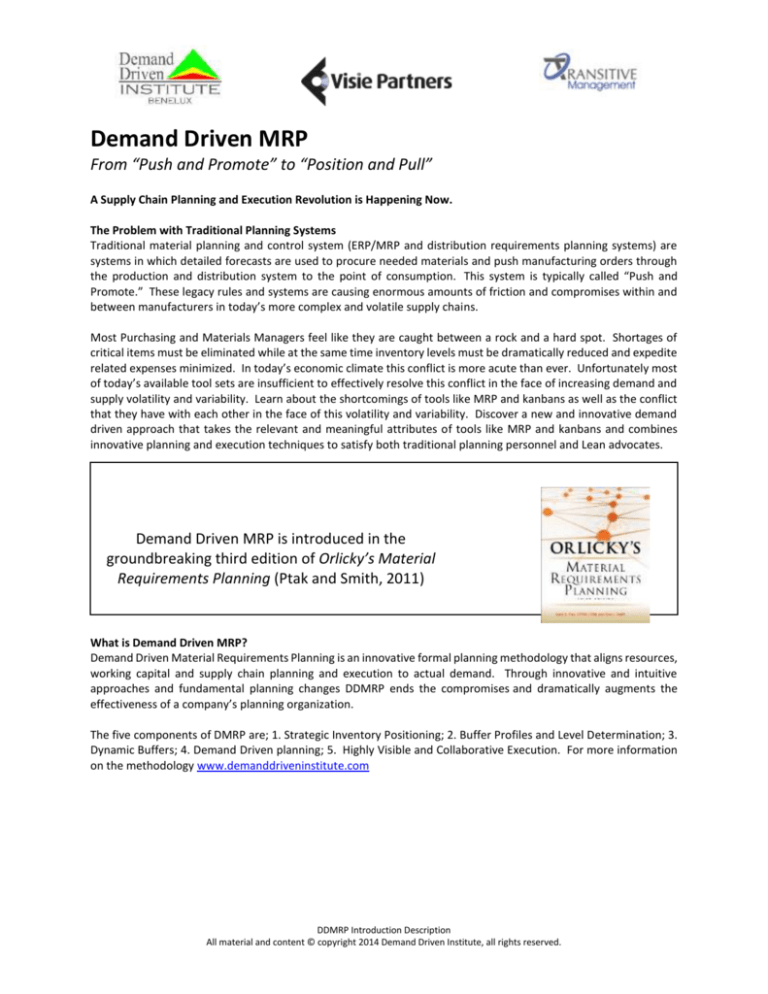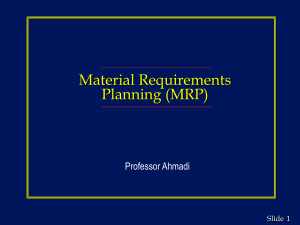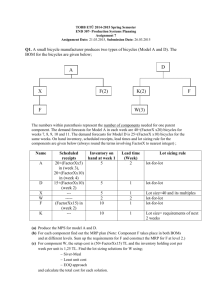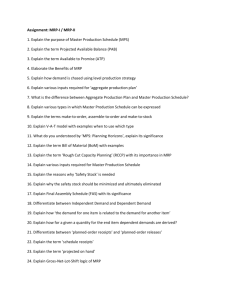
Demand Driven MRP
From “Push and Promote” to “Position and Pull”
A Supply Chain Planning and Execution Revolution is Happening Now.
The Problem with Traditional Planning Systems
Traditional material planning and control system (ERP/MRP and distribution requirements planning systems) are
systems in which detailed forecasts are used to procure needed materials and push manufacturing orders through
the production and distribution system to the point of consumption. This system is typically called “Push and
Promote.” These legacy rules and systems are causing enormous amounts of friction and compromises within and
between manufacturers in today’s more complex and volatile supply chains.
Most Purchasing and Materials Managers feel like they are caught between a rock and a hard spot. Shortages of
critical items must be eliminated while at the same time inventory levels must be dramatically reduced and expedite
related expenses minimized. In today’s economic climate this conflict is more acute than ever. Unfortunately most
of today’s available tool sets are insufficient to effectively resolve this conflict in the face of increasing demand and
supply volatility and variability. Learn about the shortcomings of tools like MRP and kanbans as well as the conflict
that they have with each other in the face of this volatility and variability. Discover a new and innovative demand
driven approach that takes the relevant and meaningful attributes of tools like MRP and kanbans and combines
innovative planning and execution techniques to satisfy both traditional planning personnel and Lean advocates.
Demand Driven MRP is introduced in the
groundbreaking third edition of Orlicky’s Material
Requirements Planning (Ptak and Smith, 2011)
What is Demand Driven MRP?
Demand Driven Material Requirements Planning is an innovative formal planning methodology that aligns resources,
working capital and supply chain planning and execution to actual demand. Through innovative and intuitive
approaches and fundamental planning changes DDMRP ends the compromises and dramatically augments the
effectiveness of a company’s planning organization.
The five components of DMRP are; 1. Strategic Inventory Positioning; 2. Buffer Profiles and Level Determination; 3.
Dynamic Buffers; 4. Demand Driven planning; 5. Highly Visible and Collaborative Execution. For more information
on the methodology www.demanddriveninstitute.com
DDMRP Introduction Description
All material and content © copyright 2014 Demand Driven Institute, all rights reserved.
CDDP Program Content
Module 1: MRP in the Modern World – the materials
challenge in the 21st Century
Key questions for planning and flexibility
Dealing with Variability
Materials or Capacity - Where to Focus First
Continued Relevancy of MRP formal planning
The Challenge of MRP in Today’s Environment
MRP and Pull-Based Methods (e.g. Lean, DBR)
The Stagnation of MRP
The MRP Conflict
Module 3: Strategic Inventory Positioning
The Positioning Factors
ASR Lead Time
ASR Lead Time and Matrix BOMs
Module 5: Buffer Profile and Level Determination
Inventory – Asset or Liability
Buffer Profiles
Buffer Zones
Calculating Buffer Levels
Continuous Improvement and Buffers
Buffer Level Summary
Module 7: Demand Driven Planning – Stocked Parts
Part Planning Designations
The DDMRP Planning Process
Supply Order Generation for Stocked Items
DDDRP Supply Order Generation
Considerations
Supply Generation for Non-Stocked Items
Decoupled Explosion
Module 9: DDMRP and Master Scheduling
DDMRP Impacts to a Master Production
Schedule
DDMRP and Capacity Scheduling Implications
DDMRP and Sales and Operations Planning
DDMRP impacts to ERP
Module 2: Demand Driven Material Requirements
Planning Introduction
What does “Demand Driven” mean?
Blending Independence and Dependence
Part Types in DDMRP
Planning and Execution
The Five Primary Components of Demand
Driven MRP
DDMRP Comparison to Past Practices
Module 4: Distribution Network Positioning
Distribution network factors
Cumulative variability
Demand driven versus push and promote
Network Configurations and Options
Module 6: Dynamic Buffers
Recalculated Adjustments
Planned Adjustments
Manual Adjustments
Module 8: Highly Visible and Collaborative Execution
Challenging Priority by Due Date
Buffer Status Alerts
Synchronization Alerts
Execution Collaboration
Module 10: DDMRP Performance Reporting and Analytics
DDMRP Performance Reporting
Analytics
DDMRP Solution Summary
Certified Demand Driven Planner (CDDP) is a trademark of the International Supply Chain Education Alliance
DDMRP Introduction Description
All material and content © copyright 2014 Demand Driven Institute, all rights reserved.
Questions and Answers:
Q.: For who is this training intended ?
A.: Business Process VP’s Directors of Supply Chain, Demand Planners, Business Operation Planners, experienced
schedulers, in other words Supply Chain Practitioners. The methodology is highly intuitively, but puts numbers to
the ‘feeling’ and enables proven control mechanisms.
Q.: What makes DDMRP so different than e.g. APICS Training Modules.
A.: DDMRP is an integral methodology which encompasses many of the elements thought by APICS. See this as an
advanced training which deals with the problems of many operational (out of date) MRP systems.
It also deals with the dynamic market conditions and sets in place tangible and operational tools in the process,
irrespective of the IT support system.
Q.: I have followed an APICS training, what is the added value of pursuing this training ?
A.: The APICS Training is a good and solid basis in Material Management and Operational Principles. The DDMRP
Training which can lead to the official and ISCEA accredited education degree of Certified Demand Driven Planner
can be seen as an advanced training. All terms and acronyms used are consistent with those used in APICS training
modules. It is not required though to be APICS certified to join the training sessions, most Supply Chain
practitioners understand the methodology well.
Q.: Which business functions benefit most by following this methodology?
A.: Source, DDMRP allows a comprehensive method to create calling off-schedules which can be managed well by
schedulers. This can be created in conjunction with your (main) suppliers.
Make; The Bill of Material can be provided with tangible ‘buffers’ and shortened lead times.
Deliver; the methodology allows for optimization of the Delivery Network
Q.: What kind of production processes are best positioned to benefit from the DDMRP Methodology ?
A.: Discrete Manufacturing, Batch Type Processing, Assembly Lines, Value Added Logistics (VAL), continuous
processing to a certain extend.
Q.: What can a Business or Process expect as Benefit from an implementation ?
A.: Shorter Lead-times, Improved (customer) Fill Rates, Higher Return of Assets (ROI), and – in most cases –
high(er) inventory turns (i.e. lower total inventories) and therefore have a positive effect on a(ny) business’ bottom
line financial performance.
Early Adopters:
DDMRP Introduction Description
All material and content © copyright 2014 Demand Driven Institute, all rights reserved.
About Carol Ptak
Carol Ptak is currently a partner with the Demand
Driven Institute, and was most recently at Pacific
Lutheran University as Visiting Professor and
Distinguished Executive in Residence. Previously,
she was vice president and global industry executive
for manufacturing and distribution industries at
PeopleSoft where she developed the concept of demand driven
manufacturing (DDM). Ms. Ptak is also a past president of APICS and has
authored several books on MRP, ERP, Lean and Theory of Constraints
(TOC).
Praise for the new Orlicky’s Material Requirements
Planning (Ptak and Smith, McGraw-Hill, 2011)
“It is in short the best book in this subject area
that I have ever seen.”
John G. Schleier Jr.
“This is a very useful and
brilliant book. Ptak and Smith
have resolved the core problems
of MRP systems.”
Eli Berniker PhD
“This comprehensive text will, in
my opinion, become THE new
standard for anyone who wants
to get ahead in manufacturing.”
William M Hewitt
“Carol and Chad: as one of the original MRPers, I
applaud you and thank you for your work, and for
advancing, with this book, our science more than any
other has done in many years.”
Bob Reary
About the Demand Driven Institute
The Demand Driven Institute (DDI) was founded by Carol Ptak and Chad Smith, coauthors of Orlicky’s Material Requirements Planning, Third Revised Edition in order
to proliferate and further develop demand driven strategy and tactics in industry.
For more information about DDMRP: www.demanddriveninstitute.com
Interested ? You can sign-up for the 2 day training will be in Soesterberg in the Netherlands
Dates in 2016: May 19-20th
Sin-up on: https://visiepartners.nl
See also Transitive Management’s Website: www.transitivemanagement.com
About Transitive Management SPRL
Transitive Management is highly specialized in end to end Supply Chain
optimization. Our team consist of senior experts and practitioners with
strong international experience .
About Visie Partners
Visie Partners is a specialized educator with programs from leading
institutes in the world in operations management, supply chain
management, purchasing, forecasting and performance improvement.
DDMRP Introduction Description
All material and content © copyright 2014 Demand Driven Institute, all rights reserved.





